Vision of Education
Download as ppt, pdf0 likes1,297 views
The document discusses various visions and predictions for the future of technology in education. It envisions a shift towards more individualized, collaborative, and self-directed learning as technology becomes more advanced and ubiquitous. Key aspects of the future vision include more flexible, adaptive, and networked models of learning; greater emphasis on lifelong learning and skills development; and stronger partnerships between education institutions and businesses.
1 of 28
Downloaded 14 times
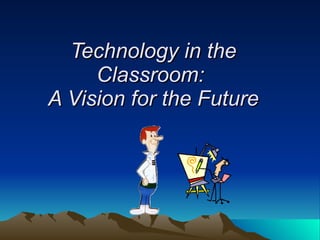
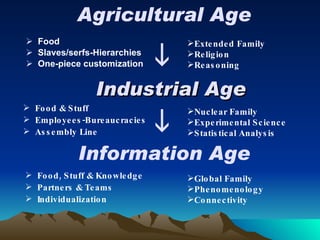
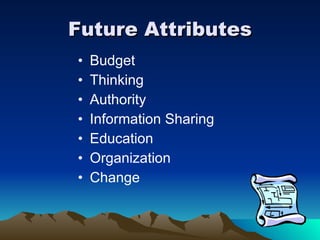

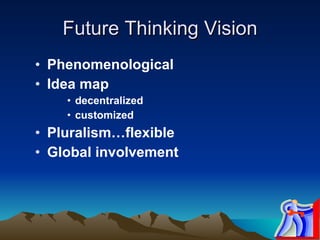
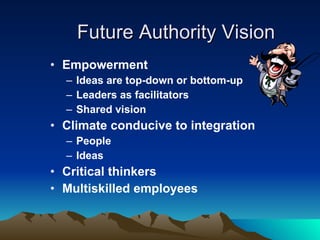
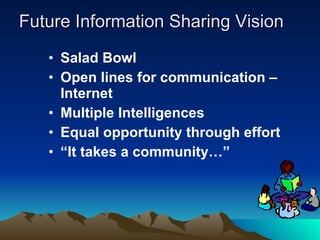

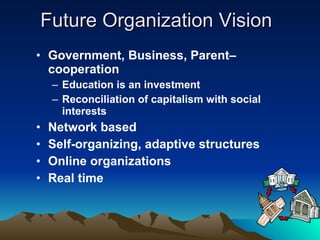
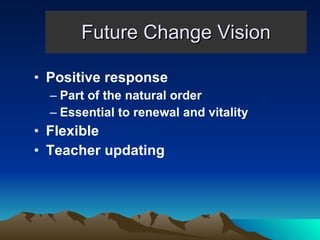
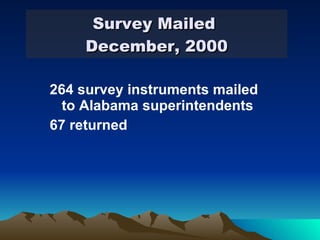
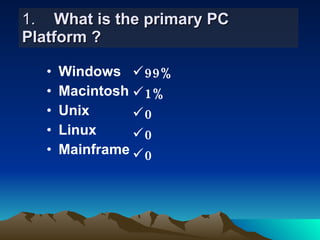
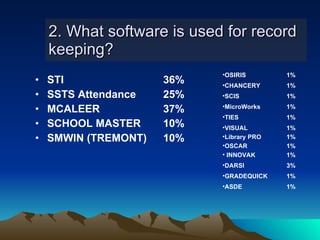
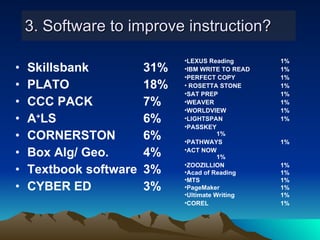
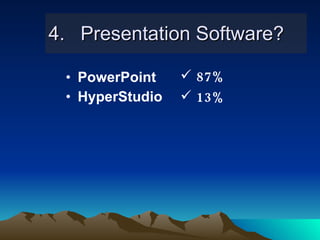
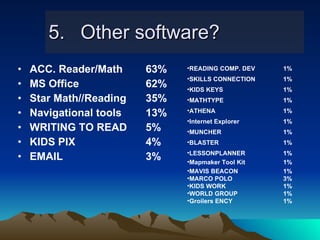
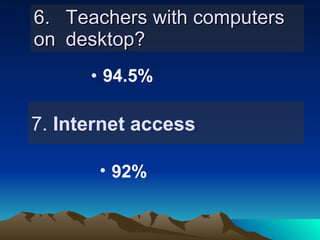
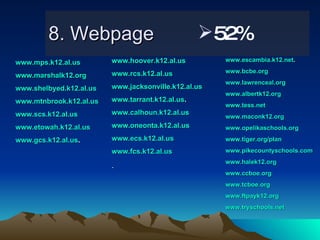
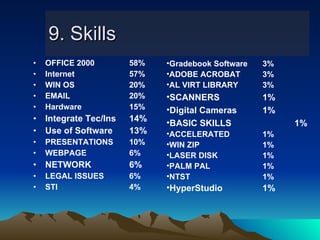



![Future Software ŌĆ£ŌĆ” software will someday get intelligent enough to give individualized tutoring that is much better than the typical classroom experience.ŌĆØ Kahn, Ken. "Re: Future of Learning." 26 February 2002. Online Posting. [IFETS-DISCUSSION:2895] . Retrieved 27 February 2003 <http://ifets.gmd.de/archiv/0685.html>](https://image.slidesharecdn.com/vision-1272057451-phpapp01/85/Vision-of-Education-23-320.jpg)
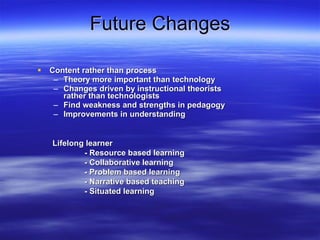

![Future Collaboration Instructional design is moving, and will continue to do so rapidly, to involve the learner more and more. Collaboration (synchronous and asynchronous) will become more important elements in our courses and participation will probably be an important factor for certified courses. Multi-user simulation exercises and games is probably the coming trend... and it is a trend that can fundamentally enhance the learner experience. Kiran Bhandari Brainvisa Technologies Ltd. From: "Kiran Bhandari" <kiran@brainvisa.com> Subject: [IFETS-DISCUSSION:3403] RE: future trends Date: Thu, 2 May 2002 16:23:52 +0530](https://image.slidesharecdn.com/vision-1272057451-phpapp01/85/Vision-of-Education-26-320.jpg)
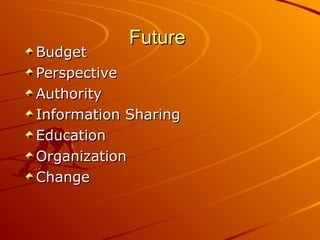
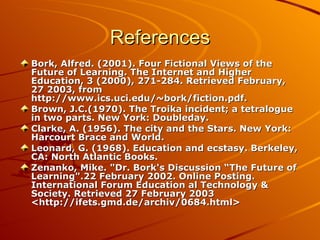
Ad
Recommended
Formative and summative evaluation (assessment of learning 2)
Formative and summative evaluation (assessment of learning 2)RMI Volunteer teacher
╠²
Formative evaluation is done during instruction to provide feedback and help teachers improve. It uses short assessments with 5-10 items daily and helps teachers decide whether to reteach, remediate, or move on. Summative evaluation is done after a unit or program to assess student achievement and compare results. It uses longer 30-50 item assessments and assigns grades to provide feedback on student performance at the end of a term. Formative evaluation informs instruction while summative evaluation assesses learning outcomes over a longer period.Social reconstructionism ppt
Social reconstructionism pptLira Lei Ann Bondoc
╠²
Social reconstructionism focuses on using education to eliminate social inequities. It aims to inform students about issues in their society, equip them with skills to enact change, and encourage them to improve society. The curriculum presents social challenges and problems to stimulate critical thinking and a desire for reform. It incorporates action-oriented lessons to teach civic responsibility. Teachers facilitate learning and foster democratic discussion to empower student voices for change.Moocs
Moocs HRDC, GJU Hisar
╠²
This document discusses the conceptual framework of MOOCs. It begins by defining MOOCs as Massive Open Online Courses and lists some popular MOOC platforms like Coursera, Udacity, and EdX. It then outlines the key characteristics of MOOCs, including their flexible and open format, self-directed learning approach, and use of asynchronous learning. The document also explains the four quadrant approach to MOOC design, which incorporates video lectures, e-content, discussion forums, and assessments. It provides guidance on developing your own MOOC, including choosing a topic, developing course materials, and using an LMS platform. Finally, it contrasts synchronous and asynchronous communication commonly used in MOOCsBlended learning
Blended learningssorden
╠²
This document discusses blended learning models and theories that combine face-to-face and online learning. It defines blended learning as an approach that combines the best aspects of both methods to create an innovative learning experience. The document outlines several blended learning models including the supplemental model, replacement model, and emporium model. It also discusses emerging trends in personalized and mobile learning that will shape students' expectations in the near future.Measurement and evaluation
Measurement and evaluationseena george
╠²
This document discusses measurement and evaluation in education. It defines key terms like tests, measurement, assessment, and evaluation. Tests are the most common method of measurement and involve posing uniform questions to measure abilities. Measurement involves assigning numbers or quantities to describe how much a learner has learned. Assessment gathers and organizes data to make decisions, while evaluation makes quality judgments about student performance. For an evaluation to be effective, it needs to be valid, reliable, objective, practical, continuous, equitable, relevant, and discriminating. The document outlines the purposes, processes, and scope of evaluation in education.Hardware approach
Hardware approach77771726
╠²
The document discusses the hardware approach to technology and communication in education. It describes the hardware approach as applying engineering principles to develop tools like films, recordings, teaching machines, and computers to aid the three aspects of human knowledge: preservation, transmission, and development. These technologies help mechanized the teaching process so teachers can educate more students with less expenditure.Historical prospective of curriculum development
Historical prospective of curriculum developmentGolnaz Azami
╠²
The document discusses the historical perspectives of curriculum development. It defines curriculum as what is taught in school, a sequence of courses, a set of subjects, performance objectives, and content. Curriculum development has been motivated by religion, politics, utilitarianism, mass education, and excellence. Traditional curriculum viewed it as rigid body of subjects prepared by teachers for students to learn from. It aimed to fit learners into the existing social order. Modern curriculum considers the total experiences of the learner and is learner-centered and flexible based on interests. It uses life experiences to prepare students for social life and values constant revision and experimental techniques.Education management information system(emis)
Education management information system(emis)PariSharma39
╠²
An Education Management Information System (EMIS) is a centralized platform for educational institutions that enables the management, analysis, and reporting of academic and administrative data. EMIS supports decision-making, planning, and evaluation by integrating various functions such as payroll, fee management, and virtual learning. It is essential for modern institutions, providing insights for administrative decisions and contributing to student success.school development plan.pdf
school development plan.pdfRahulMalhi
╠²
The document discusses the process of developing a school development plan. It explains that the plan is a roadmap that sets out changes needed to improve student achievement and shows how and when these changes will be implemented. It emphasizes involving all stakeholders in the planning process. The planning process involves analyzing the current situation through tools like SWOT and setting goals and objectives. Strategies are then developed to achieve the goals along with timelines, responsibilities and evaluation methods. Regular monitoring and review is important for the success of the plan. The overall process requires careful planning, coordination, understanding and harmony between all involved.Evaluation : Concept, Purpose, and Need
Evaluation : Concept, Purpose, and NeedForum of Blended Learning
╠²
Evaluation is a critical process aimed at assessing the effectiveness and outcomes of educational programs to enhance qualitative improvement. It involves measuring educational objectives, providing information for decision-making, and continuous assessment of teaching experiences. The purpose of evaluation includes guiding students, improving institution effectiveness, and ensuring accountability within the educational system.School and community
School and communityZarnabKhan
╠²
Schools exist as institutions to educate students and are connected to the communities in which they reside. A community is defined as a group that shares common characteristics or interests. Schools function as a subsystem within the larger societal system and must coordinate with their local community. When schools and communities partner effectively, it can lead to improved school facilities, leadership, learning programs, and new resources that benefit both students and the community at large. The main stakeholders in the school-community relationship are school administration, teachers, students, parents, and governing bodies. An effective partnership involves welcoming community participation in school activities.semester system
semester systemGhazala Muhammad Ali
╠²
The document discusses the semester system of education. It states that in the semester system, the academic year is divided into two equal parts of around six months each called semesters. Examinations are held at the end of each semester instead of yearly. This system aims to make the teaching-learning process more regular, reduce stress around examinations, and provide flexibility and variety in curriculum. However, some issues include increased workload for teachers and difficulties adjusting teaching schedules.Foundations of curriculum
Foundations of curriculumHennaAnsari
╠²
The document discusses the four foundations of curriculum: economic, psychological, philosophical, and sociological. It provides details on each foundation and how they influence curriculum development. The economic foundation focuses on job skills and market needs. The psychological foundation examines learning theories like behaviorism and cognitivism. The philosophical foundation explores perspectives like perennialism and essentialism that influence subject selection. The sociological foundation addresses how curriculum must reflect and preserve a society's culture while understanding global changes.Parents-Teacher Association
Parents-Teacher AssociationAileen MANC
╠²
The document outlines the general policy for the Parent-Teacher Association (PTA) operating in elementary and high schools, emphasizing adherence to guidelines set by the Department of Education. It details the PTA's purpose of fostering communication around school programs, supporting community coordination, and promoting student welfare, along with the organization of general assemblies to discuss programs and finances. Recognized PTAs have privileges such as collecting contributions, using school facilities, representing in governance, organizing fundraisers, and collaborating on school activities.Current trends in Education
Current trends in EducationUma Hiri
╠²
This document summarizes a presentation on adaptive teaching given at an international seminar on current trends in education. Adaptive teaching is designed to meet diverse student needs in regular classrooms by customizing curriculum based on a learner's knowledge level. It allows for flexible teaching and learning to satisfy different learning styles and levels. Examples of adaptive teaching technologies include Prodigy, Open Learning Initiative, and ALEKS. The presentation covered techniques like adaptive presentation and navigation and discussed advantages like boosting outcomes and disadvantages like costs. It concluded that adaptive teaching is suitable for 21st century learning and can transform teaching economics.Maths Co-curricular Activities : Mathematics Laboratory
Maths Co-curricular Activities : Mathematics LaboratoryForum of Blended Learning
╠²
This document discusses the importance of co-curricular activities in mathematics education. It defines co-curricular activities as activities that supplement classroom learning and help develop students' personalities. Some benefits mentioned include stimulating creative expression and developing leadership skills. The document recommends establishing a mathematics club and laboratory to organize fun activities that help generate interest in the typically "dry" subject of mathematics. Suggested activities include games, puzzles, surveys and exploring the history of mathematics. The goal is to make mathematics engaging and help students discover patterns on their own.Globalization & Higher Education
Globalization & Higher Educationgayanmedia
╠²
The document discusses the impact of globalization on higher education. It defines key terms like education, higher education, and globalization. Globalization has influenced higher education by connecting people worldwide and creating a need for graduates who can succeed in global markets. It has changed the education scenario through liberalization and privatization. The aims of global education include creating global citizens, promoting economic development, social justice, diversity, sustainability, and interconnectedness. Reforms are needed in curriculum, productivity orientation, internationalization of education, financing, and ensuring access to secondary and higher education. Teachers must take on new roles like being risk-takers, collaborators, leaders, communicators, and life-long learners to support global higher education.Types of curriculum
Types of curriculumjeniferdivya
╠²
This document discusses different types of curriculum. It describes a student-centered curriculum where children take control of their own learning and teachers facilitate. It lists characteristics like a natural approach and active student role. Advantages are that it helps students become independent and maintain interest. Disadvantages are that school values may be ignored and activities can be difficult to select. The document also discusses a fused curriculum, where two or more subjects are taught together without regard to traditional subject lines.5 e's model lesson plan
5 e's model lesson planDrGavisiddappa Angadi
╠²
The document outlines the 5 E's instructional model (engage, explore, explain, elaborate, evaluate), which is based on the constructivist approach to learning, emphasizing that students build new knowledge on prior understanding. It describes each phase of the model and provides various interactive teaching strategies like the jigsaw technique, gallery walk, concept sketches, and case studies to enhance student engagement and learning. The document promotes active inquiry-based learning through collaboration, critical thinking, and real-world application.Content for in the process of curriculum development
Content for in the process of curriculum developmentInternational advisers
╠²
This document outlines criteria for developing curriculum content and selecting appropriate content. It discusses analyzing student needs, addressing skills for future careers, ensuring the "big ideas" are covered, and using a variety of principles like validity, comprehensiveness, variety, suitability, cumulative tendency, multiple learning, and relevance. The content should be valid, useful, interesting, and learnable. It should also follow the logic of the subject matter and psychological sequence of learning.Characteristics of Gifted Children
Characteristics of Gifted ChildrenDiaa Srahin
╠²
The document discusses the characteristics of gifted children across several domains. It notes that gifted individuals exhibit high functioning in cognitive, affective, physical and intuitive areas, and that characteristics vary between individuals. Key characteristics include precociousness in learning quickly and intensity in emotional and cognitive realms. Gifted children may display intensities in psychomotor, sensual, imagination, intellectual and emotional areas. The document provides detailed descriptions of characteristics in domains of general intellectual ability, specific academic fields, creativity, artistic abilities, leadership and affective traits.Institutional planning
Institutional planningFousiya O P
╠²
Institutional planning involves an educational institution preparing a development and improvement plan based on its needs and available resources. The plan is meant to optimize resource utilization and improve the school's program and practices. Objectives of institutional planning include providing equal opportunities, improving the institution's structure, giving direction to its functioning, and developing a comprehensive improvement program through optimal use of existing resources. The process involves assessing needs, preparing long and short term plans through committees, and systematically implementing and evaluating the plans. Benefits are that it makes planning more democratic and realistic by involving stakeholders, avoids waste, and motivates teachers.Assessment and Evaluation (Some Issues and Concerns)
Assessment and Evaluation (Some Issues and Concerns)parveenpandit2019
╠²
The document discusses issues and concerns with the present system of assessment, examination, and evaluation in education. It provides an overview of the current focus on memory over understanding, stress and anxiety caused by exams, and lack of holistic evaluation. A historical perspective is given on evaluation systems in ancient China, India, England, and the introduction of standardized testing. The document outlines the processes, procedures, and characteristics of effective evaluation like reliability, validity, and objectivity. Evaluation is positioned as an ultimate tool to provide feedback to teachers, curriculum, society, parents, and students to develop their cognitive, affective, and psychomotor abilities in a holistic manner.Modelsofteaching
ModelsofteachingAni Vadakke Purayil Kannur
╠²
The document discusses various models of teaching, highlighting their definitions, characteristics, components, and instructional effects as outlined by Bruce Joyce and Marsha Weil. It categorizes teaching models into four families: information processing, personal, social interaction, and behavioral modification, each with specific goals and examples. It provides detailed descriptions of models such as concept attainment, inquiry training, and inductive thinking, emphasizing the structures and processes that guide effective teaching and learning.Approaches to Educational Planning
Approaches to Educational PlanningDr.Suresh Isave
╠²
The document discusses seven approaches to educational planning:
1. The intra-educational extrapolation model which focuses on expanding one program based on existing data.
2. The demographic projection model which estimates future population needs to determine new school/college permissions.
3. School mapping which considers geographical locations of schools from national to local levels.
4. The manpower/human resource development approach which plans education around developing needed skills.
5. The social demand approach which aims to fulfill educational needs at all levels based on societal demands.
6. The rate of return approach which views education as an investment and measures costs and benefits.
7. The social justice approach which focuses on planning education for deprived groupsUnit 2 concept of school management
Unit 2 concept of school managementAsima shahzadi
╠²
This document discusses educational management and supervision. It defines management and outlines its key functions and elements. Management is defined as an act of managing people and resources to achieve common goals. It can be considered both an art and a science. The document also discusses different levels and aspects of management, including principles of planning, organizing, staffing, leading, controlling and measuring. Objectives of educational management are provided, such as enhancing efficiency and eliminating waste.Systems approach
Systems approachalagappa university, Karaikudi
╠²
The document discusses the system approach in education. It defines a system as a set of interconnected elements that work together to achieve a specific goal. The system approach was introduced in education to better manage, control, and improve the education process. In a system approach, inputs like students and teachers go through the educational process and produce outputs like student learning, which are then analyzed for feedback to improve the system. The system approach aims to make education more organized and efficient by considering all elements as an interconnected whole.Competency Based Teacher Education and METHODS Assessing Teacher Competence.
Competency Based Teacher Education and METHODS Assessing Teacher Competence.Priyanka Nain
╠²
This document discusses competency-based teacher education. It defines teaching competency as an overall assessment of a teacher's classroom performance based on their subject matter knowledge, teaching methods, questioning skills, use of aids, student participation, personality, classroom management, and objective clarity. Competent teachers are pupil-oriented and able to develop instructional materials, use varied teaching methods, and evaluate student progress. Teaching competencies improve education quality, help students and teachers achieve objectives, improve teacher status, and aid personal and professional development. Competencies are categorized as cognitive, performance, consequence, and affective-based. Methods for assessing teacher competence include telling, lecture, discussion, demonstration, and problem-solving approaches.Emerging technology Trends and Education.ppt
Emerging technology Trends and Education.pptjagannath Dange
╠²
Emerging technologies are dramatically changing education. Teachers now use technology like online learning platforms, augmented and virtual reality, gaming elements, and data analytics to enhance interactivity and personalized learning. As technology continues to evolve, future classrooms may include immersive rooms and robotic teaching assistants. While technology improves collaboration and accessibility, it also poses challenges around privacy, algorithm bias, and preparing students for jobs that do not yet exist. Educators must help students develop skills like lifelong learning, flexibility, and social-emotional skills to thrive in a world increasingly shaped by artificial intelligence.10 Steps to an Affordable Educational Technology Plan
10 Steps to an Affordable Educational Technology PlanSam Gliksman
╠²
The document outlines a 10-step plan for developing an affordable and effective educational technology policy. It emphasizes clarifying educational vision, investing in infrastructure, adopting flexible technology models, and integrating virtual learning environments to meet 21st-century educational needs. The significance of adaptability and a shift from traditional resources to modern, technology-driven methods is stressed to prepare students for future challenges.More Related Content
What's hot (20)
school development plan.pdf
school development plan.pdfRahulMalhi
╠²
The document discusses the process of developing a school development plan. It explains that the plan is a roadmap that sets out changes needed to improve student achievement and shows how and when these changes will be implemented. It emphasizes involving all stakeholders in the planning process. The planning process involves analyzing the current situation through tools like SWOT and setting goals and objectives. Strategies are then developed to achieve the goals along with timelines, responsibilities and evaluation methods. Regular monitoring and review is important for the success of the plan. The overall process requires careful planning, coordination, understanding and harmony between all involved.Evaluation : Concept, Purpose, and Need
Evaluation : Concept, Purpose, and NeedForum of Blended Learning
╠²
Evaluation is a critical process aimed at assessing the effectiveness and outcomes of educational programs to enhance qualitative improvement. It involves measuring educational objectives, providing information for decision-making, and continuous assessment of teaching experiences. The purpose of evaluation includes guiding students, improving institution effectiveness, and ensuring accountability within the educational system.School and community
School and communityZarnabKhan
╠²
Schools exist as institutions to educate students and are connected to the communities in which they reside. A community is defined as a group that shares common characteristics or interests. Schools function as a subsystem within the larger societal system and must coordinate with their local community. When schools and communities partner effectively, it can lead to improved school facilities, leadership, learning programs, and new resources that benefit both students and the community at large. The main stakeholders in the school-community relationship are school administration, teachers, students, parents, and governing bodies. An effective partnership involves welcoming community participation in school activities.semester system
semester systemGhazala Muhammad Ali
╠²
The document discusses the semester system of education. It states that in the semester system, the academic year is divided into two equal parts of around six months each called semesters. Examinations are held at the end of each semester instead of yearly. This system aims to make the teaching-learning process more regular, reduce stress around examinations, and provide flexibility and variety in curriculum. However, some issues include increased workload for teachers and difficulties adjusting teaching schedules.Foundations of curriculum
Foundations of curriculumHennaAnsari
╠²
The document discusses the four foundations of curriculum: economic, psychological, philosophical, and sociological. It provides details on each foundation and how they influence curriculum development. The economic foundation focuses on job skills and market needs. The psychological foundation examines learning theories like behaviorism and cognitivism. The philosophical foundation explores perspectives like perennialism and essentialism that influence subject selection. The sociological foundation addresses how curriculum must reflect and preserve a society's culture while understanding global changes.Parents-Teacher Association
Parents-Teacher AssociationAileen MANC
╠²
The document outlines the general policy for the Parent-Teacher Association (PTA) operating in elementary and high schools, emphasizing adherence to guidelines set by the Department of Education. It details the PTA's purpose of fostering communication around school programs, supporting community coordination, and promoting student welfare, along with the organization of general assemblies to discuss programs and finances. Recognized PTAs have privileges such as collecting contributions, using school facilities, representing in governance, organizing fundraisers, and collaborating on school activities.Current trends in Education
Current trends in EducationUma Hiri
╠²
This document summarizes a presentation on adaptive teaching given at an international seminar on current trends in education. Adaptive teaching is designed to meet diverse student needs in regular classrooms by customizing curriculum based on a learner's knowledge level. It allows for flexible teaching and learning to satisfy different learning styles and levels. Examples of adaptive teaching technologies include Prodigy, Open Learning Initiative, and ALEKS. The presentation covered techniques like adaptive presentation and navigation and discussed advantages like boosting outcomes and disadvantages like costs. It concluded that adaptive teaching is suitable for 21st century learning and can transform teaching economics.Maths Co-curricular Activities : Mathematics Laboratory
Maths Co-curricular Activities : Mathematics LaboratoryForum of Blended Learning
╠²
This document discusses the importance of co-curricular activities in mathematics education. It defines co-curricular activities as activities that supplement classroom learning and help develop students' personalities. Some benefits mentioned include stimulating creative expression and developing leadership skills. The document recommends establishing a mathematics club and laboratory to organize fun activities that help generate interest in the typically "dry" subject of mathematics. Suggested activities include games, puzzles, surveys and exploring the history of mathematics. The goal is to make mathematics engaging and help students discover patterns on their own.Globalization & Higher Education
Globalization & Higher Educationgayanmedia
╠²
The document discusses the impact of globalization on higher education. It defines key terms like education, higher education, and globalization. Globalization has influenced higher education by connecting people worldwide and creating a need for graduates who can succeed in global markets. It has changed the education scenario through liberalization and privatization. The aims of global education include creating global citizens, promoting economic development, social justice, diversity, sustainability, and interconnectedness. Reforms are needed in curriculum, productivity orientation, internationalization of education, financing, and ensuring access to secondary and higher education. Teachers must take on new roles like being risk-takers, collaborators, leaders, communicators, and life-long learners to support global higher education.Types of curriculum
Types of curriculumjeniferdivya
╠²
This document discusses different types of curriculum. It describes a student-centered curriculum where children take control of their own learning and teachers facilitate. It lists characteristics like a natural approach and active student role. Advantages are that it helps students become independent and maintain interest. Disadvantages are that school values may be ignored and activities can be difficult to select. The document also discusses a fused curriculum, where two or more subjects are taught together without regard to traditional subject lines.5 e's model lesson plan
5 e's model lesson planDrGavisiddappa Angadi
╠²
The document outlines the 5 E's instructional model (engage, explore, explain, elaborate, evaluate), which is based on the constructivist approach to learning, emphasizing that students build new knowledge on prior understanding. It describes each phase of the model and provides various interactive teaching strategies like the jigsaw technique, gallery walk, concept sketches, and case studies to enhance student engagement and learning. The document promotes active inquiry-based learning through collaboration, critical thinking, and real-world application.Content for in the process of curriculum development
Content for in the process of curriculum developmentInternational advisers
╠²
This document outlines criteria for developing curriculum content and selecting appropriate content. It discusses analyzing student needs, addressing skills for future careers, ensuring the "big ideas" are covered, and using a variety of principles like validity, comprehensiveness, variety, suitability, cumulative tendency, multiple learning, and relevance. The content should be valid, useful, interesting, and learnable. It should also follow the logic of the subject matter and psychological sequence of learning.Characteristics of Gifted Children
Characteristics of Gifted ChildrenDiaa Srahin
╠²
The document discusses the characteristics of gifted children across several domains. It notes that gifted individuals exhibit high functioning in cognitive, affective, physical and intuitive areas, and that characteristics vary between individuals. Key characteristics include precociousness in learning quickly and intensity in emotional and cognitive realms. Gifted children may display intensities in psychomotor, sensual, imagination, intellectual and emotional areas. The document provides detailed descriptions of characteristics in domains of general intellectual ability, specific academic fields, creativity, artistic abilities, leadership and affective traits.Institutional planning
Institutional planningFousiya O P
╠²
Institutional planning involves an educational institution preparing a development and improvement plan based on its needs and available resources. The plan is meant to optimize resource utilization and improve the school's program and practices. Objectives of institutional planning include providing equal opportunities, improving the institution's structure, giving direction to its functioning, and developing a comprehensive improvement program through optimal use of existing resources. The process involves assessing needs, preparing long and short term plans through committees, and systematically implementing and evaluating the plans. Benefits are that it makes planning more democratic and realistic by involving stakeholders, avoids waste, and motivates teachers.Assessment and Evaluation (Some Issues and Concerns)
Assessment and Evaluation (Some Issues and Concerns)parveenpandit2019
╠²
The document discusses issues and concerns with the present system of assessment, examination, and evaluation in education. It provides an overview of the current focus on memory over understanding, stress and anxiety caused by exams, and lack of holistic evaluation. A historical perspective is given on evaluation systems in ancient China, India, England, and the introduction of standardized testing. The document outlines the processes, procedures, and characteristics of effective evaluation like reliability, validity, and objectivity. Evaluation is positioned as an ultimate tool to provide feedback to teachers, curriculum, society, parents, and students to develop their cognitive, affective, and psychomotor abilities in a holistic manner.Modelsofteaching
ModelsofteachingAni Vadakke Purayil Kannur
╠²
The document discusses various models of teaching, highlighting their definitions, characteristics, components, and instructional effects as outlined by Bruce Joyce and Marsha Weil. It categorizes teaching models into four families: information processing, personal, social interaction, and behavioral modification, each with specific goals and examples. It provides detailed descriptions of models such as concept attainment, inquiry training, and inductive thinking, emphasizing the structures and processes that guide effective teaching and learning.Approaches to Educational Planning
Approaches to Educational PlanningDr.Suresh Isave
╠²
The document discusses seven approaches to educational planning:
1. The intra-educational extrapolation model which focuses on expanding one program based on existing data.
2. The demographic projection model which estimates future population needs to determine new school/college permissions.
3. School mapping which considers geographical locations of schools from national to local levels.
4. The manpower/human resource development approach which plans education around developing needed skills.
5. The social demand approach which aims to fulfill educational needs at all levels based on societal demands.
6. The rate of return approach which views education as an investment and measures costs and benefits.
7. The social justice approach which focuses on planning education for deprived groupsUnit 2 concept of school management
Unit 2 concept of school managementAsima shahzadi
╠²
This document discusses educational management and supervision. It defines management and outlines its key functions and elements. Management is defined as an act of managing people and resources to achieve common goals. It can be considered both an art and a science. The document also discusses different levels and aspects of management, including principles of planning, organizing, staffing, leading, controlling and measuring. Objectives of educational management are provided, such as enhancing efficiency and eliminating waste.Systems approach
Systems approachalagappa university, Karaikudi
╠²
The document discusses the system approach in education. It defines a system as a set of interconnected elements that work together to achieve a specific goal. The system approach was introduced in education to better manage, control, and improve the education process. In a system approach, inputs like students and teachers go through the educational process and produce outputs like student learning, which are then analyzed for feedback to improve the system. The system approach aims to make education more organized and efficient by considering all elements as an interconnected whole.Competency Based Teacher Education and METHODS Assessing Teacher Competence.
Competency Based Teacher Education and METHODS Assessing Teacher Competence.Priyanka Nain
╠²
This document discusses competency-based teacher education. It defines teaching competency as an overall assessment of a teacher's classroom performance based on their subject matter knowledge, teaching methods, questioning skills, use of aids, student participation, personality, classroom management, and objective clarity. Competent teachers are pupil-oriented and able to develop instructional materials, use varied teaching methods, and evaluate student progress. Teaching competencies improve education quality, help students and teachers achieve objectives, improve teacher status, and aid personal and professional development. Competencies are categorized as cognitive, performance, consequence, and affective-based. Methods for assessing teacher competence include telling, lecture, discussion, demonstration, and problem-solving approaches.Similar to Vision of Education (20)
Emerging technology Trends and Education.ppt
Emerging technology Trends and Education.pptjagannath Dange
╠²
Emerging technologies are dramatically changing education. Teachers now use technology like online learning platforms, augmented and virtual reality, gaming elements, and data analytics to enhance interactivity and personalized learning. As technology continues to evolve, future classrooms may include immersive rooms and robotic teaching assistants. While technology improves collaboration and accessibility, it also poses challenges around privacy, algorithm bias, and preparing students for jobs that do not yet exist. Educators must help students develop skills like lifelong learning, flexibility, and social-emotional skills to thrive in a world increasingly shaped by artificial intelligence.10 Steps to an Affordable Educational Technology Plan
10 Steps to an Affordable Educational Technology PlanSam Gliksman
╠²
The document outlines a 10-step plan for developing an affordable and effective educational technology policy. It emphasizes clarifying educational vision, investing in infrastructure, adopting flexible technology models, and integrating virtual learning environments to meet 21st-century educational needs. The significance of adaptability and a shift from traditional resources to modern, technology-driven methods is stressed to prepare students for future challenges.What will schools_look_like_in_2020_
What will schools_look_like_in_2020_Will Richardson
╠²
The document discusses how schools may change by 2020 due to new digital technologies and learning environments. It argues that schools will need to adapt from standardized, teacher-directed models to personalized, self-directed, lifelong learning. Key shifts include learning becoming more mobile, networked, global, and interest-driven rather than confined to the classroom. Literacy will require skills like collaborating online, managing multiple information streams, and creating multimedia content. Schools will face challenges but can leverage technology to provide personalized learning instead of a one-size-fits-all approach. Educators will need preparation and experiences using technology to inspire innovative teaching practices.What will schools_look_like_in_2020_
What will schools_look_like_in_2020_Will Richardson
╠²
The document discusses how schools may change by 2020 due to new technologies and learning environments. It notes that learning will become more mobile, networked, global, collaborative, self-directed and personalized. This represents a huge challenge for traditional schools. Literacy will also change and require skills like developing technology proficiency, collaborating online, and managing multiple information streams. Schools will need to adapt learning resources and assessments to engage students in new ways. Educators will need new preparation focused on technology to improve learning. Infrastructure changes are also needed to provide all students and educators access to internet and devices for learning anywhere.WEB2.0: Preparing students for their world not ours.
WEB2.0: Preparing students for their world not ours.Anne-Mart Olsen
╠²
The document discusses the need for educational systems to adapt to the unique needs of digital natives, who are fluent in technology, as opposed to digital immigrants, who may struggle with it. It emphasizes the importance of fostering personalized and self-directed learning environments that embrace new technologies rather than relying solely on traditional methods. The text further highlights the cultural and communicative shifts caused by advancements in technology and the implications for education.Learning Environment and Design Current and Future Impacts.pptx
Learning Environment and Design Current and Future Impacts.pptxARSENIOJRMIRANDO
╠²
The document discusses the evolution of educational technology from basic tools like chalkboards to advanced digital environments featuring AI, gamification, and immersive learning technologies. It examines current impacts such as personalized and collaborative learning experiences while forecasting future trends in education that will shape how learners engage with content. The focus is on creating inclusive, equitable, and dynamic learning environments to empower students and enhance their educational experiences.Instructional technologyhistoryfuture
Instructional technologyhistoryfutureIngrid Johnson Conway
╠²
Instructional technology is defined as the analysis, design, development, implementation, and evaluation of processes and resources for learning. It involves improving learning through instructional and non-instructional processes. Instructional design is a systematic process used to develop education and training programs in a consistent way through ongoing evaluation. The field has evolved over time from a focus on instructional media to include personal computers, the internet, and now wireless tools. The future of instructional technology is expected to involve ubiquitous learning through personal mobile devices and delivering more education with less physical space.Technology Assign 2 Edp128
Technology Assign 2 Edp128DEE KELLY
╠²
The document discusses how technology is rapidly changing the landscape of education. It notes that today's students have grown up with digital technologies and process information visually rather than through traditional reading and lectures. While some argue this could isolate students, interactive whiteboards and other classroom technologies allow for more collaborative learning. The role of teachers is shifting from solely instructors to facilitators, mentors and guides. Overall, the document argues that embracing technological advancement will improve teaching and ensure students develop skills to be knowledgeable citizens. However, teachers require ongoing professional development and experience with new technologies to effectively integrate them into lessons.Technology Assign 2 Edp128
Technology Assign 2 Edp128DEE KELLY
╠²
The document discusses how technology is rapidly changing the landscape of education. It notes that today's students have grown up with digital technologies and process information visually rather than through traditional reading and lectures. While some argue this could isolate students, interactive whiteboards and other classroom technologies allow for more collaborative learning. The role of teachers is shifting from direct instruction to mentoring as students take a more active role in constructing their own knowledge. Overall, the document argues that embracing new technologies will improve teaching and learning by better engaging today's students and preparing them to be knowledgeable citizens.Edtc6320 kknisely project5
Edtc6320 kknisely project5Kari
╠²
The document discusses the history and future of instructional technology. It traces developments from the 1920s to the present, including major changes driven by events like the World Wars and rise of the internet. Going forward, it argues that changes in how people learn require adapting teaching methods and embracing new technologies. Preparing students with 21st century skills will be crucial to remaining competitive globally.FUTURE OF EDU. DR SOHAIB.pptx
FUTURE OF EDU. DR SOHAIB.pptxMSAkhtar5
╠²
The document discusses the past, present and future of education. In the past, education involved chalkboards and group studies. Currently, powerpoint and internet are widely used. In the future, education may become more accessible through distance learning and the use of social media and mobile technologies. Challenges will include keeping students focused without direct supervision and ensuring all students can benefit from new technologies.New learning paradigms and technologies
New learning paradigms and technologiesFrederik Questier
╠²
This presentation discusses new learning paradigms and technologies. It begins by noting that the future is unpredictable and students today may not realize how much their professional lives will change. It then discusses trends like the technological singularity, increasing connectivity through devices and the internet of things, and how information abundance has replaced scarcity. The presentation advocates preparing students for this unknown future by focusing on skills like social skills, creativity, and lifelong learning rather than only transmitting knowledge. It also promotes active, collaborative, and constructionist approaches to learning over passive absorption of knowledge.Educational technology
Educational technologyBharti Kumari
╠²
Educational technology has evolved from early foundations in instructional design and educational media. Over the 20th century, it was influenced by behaviorism, cognitivism, and constructivism. Today, instructional design, educational media, and educational computing have converged into the field of educational technology. Looking ahead, technology is expected to become more integrated into teaching and learning, enabling distributed, lifelong learning available anytime and anywhere.Engaging
EngagingSandi Hodgson
╠²
The document discusses how today's students learn differently than in the past due to technology. It notes students are used to engaging with digital media and may not engage as well with traditional classroom learning. It suggests supplementing the curriculum with digital tools like blogs, wikis, and multimedia projects that allow students to reflect their understanding in real and engaging ways. By incorporating the technologies students already use, teachers can better facilitate learning for digital learners.Potential Emerging Technology PowerPoint
Potential Emerging Technology PowerPointguestb0a181c
╠²
The document outlines five key technology trends in K-12 education for 2010, emphasizing the integration of educational video games to enhance preschool literacy and the adoption of 3-D learning technologies. It discusses the potential of eBooks, interactive whiteboards, and personal assessment tools in improving educational outcomes, especially in math, science, and engineering. The analysis highlights that while these technological advancements could revolutionize learning, economic challenges may delay their widespread implementation in schools.Overview Of Ist
Overview Of IstIntrist
╠²
The document discusses instructional systems technology (IST). IST focuses on using information and communication technologies to support trends in education like e-learning, virtual universities, lifelong learning, and self-learning. IST professionals develop innovative and interactive solutions for education and training. The document outlines characteristics of IST students, including learning creatively, thinking differently, and taking on challenges. It also discusses the history of instructional technology from its use in WWII military training to later developments in instructional media, computing, and design.Ian Wigglesworth Mod 3b 6620
Ian Wigglesworth Mod 3b 6620Ian Wigglesworth
╠²
This document discusses trends in educational technology including: 1) Autonomous-experiential learning enabled by new augmented reality devices that allow seamless integration of technology into education; 2) Electronic media replacing textbooks with continuously updated, collaboratively edited open data; 3) Teachers evolving from content experts to technology specialists who facilitate student-centered learning and research skills.21StCenturyLearner-2
21StCenturyLearner-2Faisal Rahim
╠²
Science classrooms in 2020 and 2030 will likely see changes in technology use and teaching strategies. Students will be more engaged through problem-based and collaborative learning using technologies. Digital textbooks will become more common, featuring interactive elements, videos, and online assessments. However, some argue that an over-emphasis on entertainment over engagement could hinder learning. Predicting the future is difficult, as past predictions of leisure time and limited technological change have proven inaccurate. The role of teachers will be to focus on developing skills like critical thinking over simple content delivery.Instructional Flow Matrix: A conceptual tool for hybrid learning design
Instructional Flow Matrix: A conceptual tool for hybrid learning designThe Transformation Society
╠²
This document discusses the instructional flow matrix as a conceptual tool for hybrid learning design. It provides context on post-COVID mindsets and paradigm shifts. The authors propose a 3D learner-centered matrix that considers 1) the human interaction environment, 2) the cognitive learning process, and 3) institutional recognition. New emerging paradigms discussed include privacy/identity, health/well-being, and human rights. The document reflects on challenges of immersive reality and how educational systems can address diversity, personalization and informal learning.The Future Of Technology In Education by Tara Humber
The Future Of Technology In Education by Tara HumberMUN
╠²
The document discusses emerging technologies that could impact K-12 education, including interactive whiteboards, tablets, virtual reality systems, and programmable blocks. It notes that these tools can enhance learning by making it more hands-on, collaborative, and tailored to individual needs. However, it also stresses that teachers need training and support to integrate new technologies effectively and avoid potential downsides like "de-skilling." Overall, the document presents an optimistic view of how upcoming hardware, software, and networking could improve engagement if implemented appropriately.Ad
Vision of Education
- 1. Technology in the Classroom: A Vision for the Future
- 2. Industrial Age Food Slaves/serfs-Hierarchies One-piece customization Agricultural Age ’ü® Information Age ’ü® Extended Family Religion Reasoning Food & Stuff Employees-Bureaucracies Assembly Line Nuclear Family Experimental Science Statistical Analysis Global Family Phenomenology Connectivity Food, Stuff & Knowledge Partners & Teams Individualization
- 3. Future Attributes Budget Thinking Authority Information Sharing Education Organization Change
- 4. Future Budget Vision Seek investment Parents Business Quality control SAT Graduation exams Inclusive Employee preparation Software, hardware Health
- 5. Future Thinking Vision Phenomenological Idea map decentralized customized PluralismŌĆ”flexible Global involvement
- 6. Future Authority Vision Empowerment Ideas are top-down or bottom-up Leaders as facilitators Shared vision Climate conducive to integration People Ideas Critical thinkers Multiskilled employees
- 7. Future Information Sharing Vision Salad Bowl Open lines for communication ŌĆō Internet Multiple Intelligences Equal opportunity through effort ŌĆ£ It takes a communityŌĆ”ŌĆØ
- 8. Future Education Vision Broad education programs Student centered Constructivist Charter schools School vouchers On-Line education People who can continuously learn Real world learning Business adaptations/internships Safety
- 9. Future Organization Vision Government, Business, ParentŌĆō cooperation Education is an investment Reconciliation of capitalism with social interests Network based Self-organizing, adaptive structures Online organizations Real time
- 10. Future Change Vision Positive response Part of the natural order Essential to renewal and vitality Flexible Teacher updating
- 11. Survey Mailed December, 2000 264 survey instruments mailed to Alabama superintendents 67 returned
- 12. 1. What is the primary PC Platform ? Windows Macintosh Unix Linux Mainframe 99% 1% 0 0 0
- 13. 2. What software is used for record keeping? STI 36% SSTS Attendance 25% MCALEER 37% SCHOOL MASTER 10% SMWIN (TREMONT) 10% OSIRIS 1% CHANCERY 1% SCIS 1% MicroWorks 1% TIES 1% VISUAL 1% Library PRO 1% OSCAR 1% INNOVAK 1% DARSI 3% GRADEQUICK 1% ASDE 1%
- 14. 3. Software to improve instruction? Skillsbank 31% PLATO 18% CCC PACK 7% A + LS 6% CORNERSTON 6% Box Alg/ Geo. 4% Textbook software 3% CYBER ED 3% LEXUS Reading 1% IBM WRITE TO READ 1% PERFECT COPY 1% ROSETTA STONE 1% SAT PREP 1% WEAVER 1% WORLDVIEW 1% LIGHTSPAN 1% PASSKEY 1% PATHWAYS 1% ACT NOW 1% ZOOZILLION 1% Acad of Reading 1% MTS 1% PageMaker 1% Ultimate Writing 1% COREL 1%
- 15. 4. Presentation Software? PowerPoint HyperStudio 87% 13%
- 16. 5. Other software? ACC. Reader/Math 63% MS Office 62% Star Math//Reading 35% Navigational tools 13% WRITING TO READ 5% KIDS PIX 4% EMAIL 3% READING COMP. DEV 1% SKILLS CONNECTION 1% KIDS KEYS 1% MATHTYPE 1% ATHENA 1% Internet Explorer 1% MUNCHER 1% BLASTER 1% LESSONPLANNER 1% Mapmaker Tool Kit 1% MAVIS BEACON 1% MARCO POLO 3% KIDS WORK 1% WORLD GROUP 1% Groilers ENCY 1%
- 17. 94.5% 6. Teachers with computers on desktop? 7. Internet access 92%
- 18. 8. Webpage 52% www.mps.k12.al.us www.marshalk12.org www.shelbyed.k12.al.us www.mtnbrook.k12.al.us www.scs.k12.al.us www.etowah.k12.al.us www.gcs.k12.al.us . www.hoover.k12.al.us www.rcs.k12.al.us www.jacksonville.k12.al.us www.tarrant.k12.al.us . www.calhoun.k12.al.us www.oneonta.k12.al.us www.ecs.k12.al.us www.fcs.k12.al.us . www.escambia.k12.net . www.bcbe.org www.lawrenceal.org www.albertk12.org www.tess.net www.maconk12.org www.opelikaschools.org www.tiger.org/plan www.pikecountyschools.com www.halek12.org www.ccboe.org www.tcboe.org www.ftpayk12.org www.tryschools.net
- 19. 9. Skills OFFICE 2000 58% Internet 57% WIN OS 20% EMAIL 20% Hardware 15% Integrate Tec/Ins 14% Use of Software 13% PRESENTATIONS 10% WEBPAGE 6% NETWORK 6% LEGAL ISSUES 6% STI 4% Gradebook Software 3% ADOBE ACROBAT 3% AL VIRT LIBRARY 3% SCANNERS 1% Digital Cameras 1% BASIC SKILLS 1% ACCELERATED 1% WIN ZIP 1% LASER DISK 1% PALM PAL 1% NTST 1% HyperStudio 1%
- 20. Problems of Teachers Lack of time due to abundance tasks No experiences in multimedia teaching Rarely work in collaborative environment Some teachers do not buy-in-to using software Prohibitive long term costs involved with new technological developments Low motivation in using the www for searching teaching materials Not interested in creating courseware
- 21. Jacksonville State University Teacher preparation Clinical experiences EIM teacher preparation courses TSPAT for teachers in the field Challenges Consolidation of schools of education Economy of courses yet increase in requirements by the SDE and accrediting organizations
- 22. Future Hardware MooreŌĆÖs Law Processing Speed and Storage MultimediaŌĆöMultiformat Virtual Learning and Simulations Gloves and Visors Dedicated rooms Wireless
- 23. Future Software ŌĆ£ŌĆ” software will someday get intelligent enough to give individualized tutoring that is much better than the typical classroom experience.ŌĆØ Kahn, Ken. "Re: Future of Learning." 26 February 2002. Online Posting. [IFETS-DISCUSSION:2895] . Retrieved 27 February 2003 <http://ifets.gmd.de/archiv/0685.html>
- 24. Future Changes Content rather than process Theory more important than technology Changes driven by instructional theorists rather than technologists Find weakness and strengths in pedagogy Improvements in understanding Lifelong learner - Resource based learning - Collaborative learning - Problem based learning - Narrative based teaching - Situated learning
- 25. Future Schools? ------------------------------ Date: Wed, 17 Mar 2004 10:55:49 -0500 From: Bill Ellis <tranet@RANGELEY.ORG> Subject: Re: IFETS-DISCUSSION Re: PARADIGM SHIFT The current school system is authoritarian, hierarchal, and undemocratic. The social system is authoritarian, hierarchical and undemocratic. Connecting these was the thesis of Paulo Friere. Ivan Illich added that the values and life styles absorbed in schools were self-interest, competition, and materialism -- the so called "Dominator Paradigm" the root of the Euro American Culture. An emerging "Gaian Paradigm" is rooted in a new scientific understanding that everything in the universe is a holon, composed on smaller holons and embedded in larger holons. That is, each of us, (and everything else), is dependent on every one else (and everything else). Every individual is composed of organs, cells, molecules, atoms etc. and embedded in family, community, society, nature, the earth, etc. All are interconnected and interdependent. We each "belong" to Gaia (The Earth and all of it life forms). We must discover and obey the laws of Gaia to continue human existencd. We each "belong" to one another. We are interdependent. We are responsible to Gaia and for Gaia. We are responsible for one another. We cannot abrogate that responsibility to others -- including the government. Our personal learning is our personal responsibility. The future of society is our personal responsibility. The transition from the Dominator Paradigm to the Gaian paradigm suggests a transition from government schools to learning communities. A transition to Life-Long Self-Learning. And it is happening. Just my thoughts. IMHO Bill Ellis, General Coordinator A Coalition for Self-Learning POBox 567 Rangeley, ME 04970 USA
- 26. Future Collaboration Instructional design is moving, and will continue to do so rapidly, to involve the learner more and more. Collaboration (synchronous and asynchronous) will become more important elements in our courses and participation will probably be an important factor for certified courses. Multi-user simulation exercises and games is probably the coming trend... and it is a trend that can fundamentally enhance the learner experience. Kiran Bhandari Brainvisa Technologies Ltd. From: "Kiran Bhandari" <kiran@brainvisa.com> Subject: [IFETS-DISCUSSION:3403] RE: future trends Date: Thu, 2 May 2002 16:23:52 +0530
- 27. Future Budget Perspective Authority Information Sharing Education Organization Change
- 28. References Bork, Alfred. (2001). Four Fictional Views of the Future of Learning. The Internet and Higher Education, 3 (2000), 271-284. Retrieved February, 27 2003, from http://www.ics.uci.edu/~bork/fiction.pdf. Brown, J.C.(1970). The Troika incident; a tetralogue in two parts. New York: Doubleday. Clarke, A. (1956). The city and the Stars. New York: Harcourt Brace and World. Leonard, G. (1968). Education and ecstasy. Berkeley, CA: North Atlantic Books. Zenanko, Mike. "Dr. Bork's Discussion ŌĆ£The Future of Learning".22 February 2002. Online Posting. International Forum Education al Technology & Society. Retrieved 27 February 2003 <http://ifets.gmd.de/archiv/0684.html>
